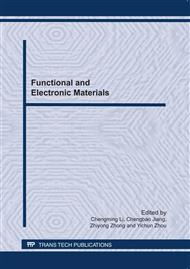p.463
p.467
p.474
p.480
p.485
p.490
p.494
p.500
p.505
High Damping Capacity of a Binary TiNi Shape Memory Alloy
Abstract:
TiNi shape memory alloys exhibiting high damping capacity are currently expected to be used as structural materials for energy dissipation or vibration control applications. In this paper, the characterization of damping behaviour of a binary TiNi SMA was performed by dynamic mechanical analyzer (DMA) instrument and differential scanning calorimetry (DSC) equipment. Damping tests measuring Tanδ, storage modulus E' and loss modulus E" of Ti49.2Ni50.8 binary shape memory alloy were investigated at different temperature, using different frequency and strain amplitude. It shows that quenching rate has a significant effect on the damping capacity of TiNi SMA by exhibiting different phase transformation behavior. Internal friction values (Q-1) corresponding to cubic B2 parent phase to rhombohedral R phase transformation, B2-R, and R-B19' monoclinic martensite transformation are as high as 0.177 and 0.078, respectively. The occurrence of R-phase significantly softens the storage modulus and thus promotes the damping capacity of TiNi SMAs.
Info:
Periodical:
Pages:
485-489
Citation:
Online since:
June 2011
Authors:
Price:
Сopyright:
© 2011 Trans Tech Publications Ltd. All Rights Reserved
Share:
Citation:


